The Cardiac Microenvironment Instructs Divergent Monocyte Fates and Functions in Myocarditis
- PMID: 31269438
- PMCID: PMC6813836
- DOI: 10.1016/j.celrep.2019.06.007
The Cardiac Microenvironment Instructs Divergent Monocyte Fates and Functions in Myocarditis
Abstract
Two types of monocytes, Ly6Chi and Ly6Clo, infiltrate the heart in murine experimental autoimmune myocarditis (EAM). We discovered a role for cardiac fibroblasts in facilitating monocyte-to-macrophage differentiation of both Ly6Chi and Ly6Clo cells, allowing these macrophages to perform divergent functions in myocarditis progression. During the acute phase of EAM, IL-17A is highly abundant. It signals through cardiac fibroblasts to attenuate efferocytosis of Ly6Chi monocyte-derived macrophages (MDMs) and simultaneously prevents Ly6Clo monocyte-to-macrophage differentiation. We demonstrated an inverse clinical correlation between heart IL-17A levels and efferocytic receptor expressions in humans with heart failure (HF). In the absence of IL-17A signaling, Ly6Chi MDMs act as robust phagocytes and are less pro-inflammatory, whereas Ly6Clo monocytes resume their differentiation into MHCII+ macrophages. We propose that MHCII+Ly6Clo MDMs are associated with the reduction of cardiac fibrosis and prevention of the myocarditis sequalae.
Keywords: Ly6C; MerTK; heart; macrophages; monocytes; myocarditis.
Copyright © 2019 The Author(s). Published by Elsevier Inc. All rights reserved.
Conflict of interest statement
DECLARATION OF INTERESTS
The authors declare no competing interests.
Figures
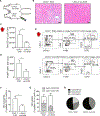
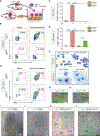

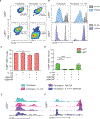
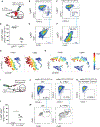

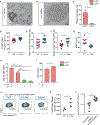
Similar articles
-
Ly6CHi Blood Monocyte/Macrophage Drive Chronic Inflammation and Impair Wound Healing in Diabetes Mellitus.Arterioscler Thromb Vasc Biol. 2018 May;38(5):1102-1114. doi: 10.1161/ATVBAHA.118.310703. Epub 2018 Mar 1. Arterioscler Thromb Vasc Biol. 2018. PMID: 29496661 Free PMC article.
-
ANG II facilitated CD11+ Ly6Chi cells reprogramming into M1-like macrophage through Erk1/2 or p38-Stat3 pathway and involved in EAM.J Leukoc Biol. 2018 Apr;103(4):719-730. doi: 10.1002/JLB.3A0617-264RR. Epub 2018 Jan 19. J Leukoc Biol. 2018. PMID: 29350825
-
The monocyte to macrophage transition in the murine sterile wound.PLoS One. 2014 Jan 22;9(1):e86660. doi: 10.1371/journal.pone.0086660. eCollection 2014. PLoS One. 2014. PMID: 24466192 Free PMC article.
-
Occurrences and Functions of Ly6Chi and Ly6Clo Macrophages in Health and Disease.Front Immunol. 2022 May 30;13:901672. doi: 10.3389/fimmu.2022.901672. eCollection 2022. Front Immunol. 2022. PMID: 35707538 Free PMC article. Review.
-
Pathogenesis of myocarditis and dilated cardiomyopathy.Adv Immunol. 2008;99:95-114. doi: 10.1016/S0065-2776(08)00604-4. Adv Immunol. 2008. PMID: 19117533 Review.
Cited by
-
Myocarditis and inflammatory cardiomyopathy: current evidence and future directions.Nat Rev Cardiol. 2021 Mar;18(3):169-193. doi: 10.1038/s41569-020-00435-x. Epub 2020 Oct 12. Nat Rev Cardiol. 2021. PMID: 33046850 Free PMC article. Review.
-
A model-informed approach to assess the risk of immune checkpoint inhibitor-induced autoimmune myocarditis.Front Pharmacol. 2022 Sep 26;13:966180. doi: 10.3389/fphar.2022.966180. eCollection 2022. Front Pharmacol. 2022. PMID: 36249751 Free PMC article. Review.
-
Cellular Immunology of Myocarditis: Lights and Shades-A Literature Review.Cells. 2024 Dec 17;13(24):2082. doi: 10.3390/cells13242082. Cells. 2024. PMID: 39768171 Free PMC article. Review.
-
The distinct functions of MIF in inflammatory cardiomyopathy.Front Immunol. 2025 Feb 28;16:1544484. doi: 10.3389/fimmu.2025.1544484. eCollection 2025. Front Immunol. 2025. PMID: 40092999 Free PMC article. Review.
-
The role of IL-17 family cytokines in cardiac fibrosis.Front Cardiovasc Med. 2024 Oct 22;11:1470362. doi: 10.3389/fcvm.2024.1470362. eCollection 2024. Front Cardiovasc Med. 2024. PMID: 39502194 Free PMC article. Review.
References
-
- Amit I, Winter DR, and Jung S (2016). The role of the local environment and epigenetics in shaping macrophage identity and their effect on tissue homeostasis. Nat. Immunol. 17, 18–25. - PubMed
-
- Amoah BP, Yang H, Zhang P, Su Z, and Xu H (2015). Immunopathogenesis of Myocarditis: The Interplay Between Cardiac Fibroblast Cells, Dendritic Cells, Macrophages and CD4+ T Cells. Scand. J. Immunol. 82, 1–9. - PubMed
Publication types
MeSH terms
Substances
Grants and funding
LinkOut - more resources
Full Text Sources
Molecular Biology Databases
Research Materials
Miscellaneous

